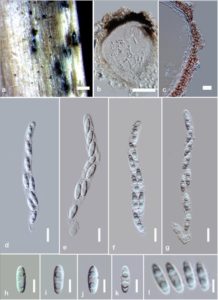Phomatospora biseriata Senan., Camporesi & K.D. Hyde, sp. nov. ; Index Fungorum number IF552313
Etymology: Based on the ascospores having longitudinal striations.
Holotype: MFLU 16–1970
Saprobic on Clematis vitalba L. Sexual morph: Ascomata 115–170 μm high × 125–200 μm diam., (x = 152 × 150 μm, n = 10), solitary to aggregated, immersed and becoming erumpent with age, globose to subglobose, membranous, coriaceous, brown, ostiolate, papillate. Papilla 43–66 μm high, 46–63 μm wide (x = 50 × 45 μm, n = 10), short, central or eccentric, broadly conical, periphysate, covered with black. Peridium 5–15 μm wide (x = 11 μm, n =10), comprising inner, hyaline, thick-walled elongated cells and outer, brown, thick-walled elongate cells. Hamathecium comprising few, hypha-like, thin-walled, fragile, septate, constricted at septa, hyaline, paraphyses tapering above and shorter than asci. Asci 200–230 × 19–23 μm (x = 207 × 22 μm, n =20), 8-spored, unitunicate, cylindrical to fusiform, thin-walled, pedicellate, with a refractive, J-, apical ring. Ascospores 25–29 × 9–11.5 μm (x = 27 × 10 μm, n =20), overlapping uniseriate, ellipsoidal, hyaline, unicellular, bi-guttulate, guttules located at the ends of the cell, longitudinally striate. Asexual morph: Undetermined.
Culture characters: Colonies growing on MEA attenuated 1 cm within 14 days incubated at 18°C, slow growing, lacking aerial mycelium, tightly attached to the media, irregular, convex, undulate, cream to olivaceous.
Material examined: ITALY, Province of Forlì-Cesena near Premilcuore, dead branch of Clematis vitalba L. (Ranunculaceae), 1 March 2013, Erio Camporesi, IT 1085, (MFLU 16–1970 holotype), ex-type living cultures, MFLUCC 14–0832.
Notes: Phomatospora biseriata clusters in the Phomatospora clade as a distinct species. The overlapping uniseriate to biseriate ascospore arrangement is unusual in Phomatospora. Hence here we introduce it as a new species. There are no Phomatospora species reported from Clematis (Index Fungorum 2016, Farr & Rossman 2016).
Fig. Phomatospora biseriata (holotype). a. Appearance of ascomata on substrate. b. Cross section of ascoma. c. Peridium. d–g. Asci. h–k. Ascospores. l. Indistinct longitudinal striations. Scale bars: a = 200 μm, b = 50 μm, c-g = 10 μm, h-l = 5 μm.

